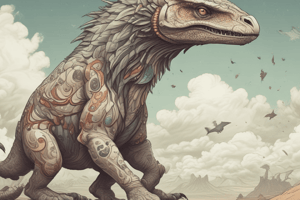Podcast
Questions and Answers
What term did Charles Darwin use to describe the process by which populations evolve over time due to differences in individual survival and reproductive success?
What term did Charles Darwin use to describe the process by which populations evolve over time due to differences in individual survival and reproductive success?
- Mutation
- Genetic drift
- Natural selection (correct)
- Migration
Individuals with certain traits have a higher likelihood of surviving and reproducing more offspring due to those traits. What describes this phenomenon?
Individuals with certain traits have a higher likelihood of surviving and reproducing more offspring due to those traits. What describes this phenomenon?
- Natural selection (correct)
- Gene flow
- Speciation
- Bottleneck effect
What concept refers to the ability of some members of a species to survive better than others due to having beneficial traits that enable them to adapt to their environment?
What concept refers to the ability of some members of a species to survive better than others due to having beneficial traits that enable them to adapt to their environment?
- Hardy-Weinberg equilibrium
- Founder effect
- Survival of the fittest (correct)
- Random mating
Which term is used to describe how populations evolve over time due to random changes in allele frequencies?
Which term is used to describe how populations evolve over time due to random changes in allele frequencies?
What does the term 'adaptation' refer to in the context of evolution?
What does the term 'adaptation' refer to in the context of evolution?
In the process of natural selection, what are passed down from generation to generation that lead to certain traits becoming more common within a population?
In the process of natural selection, what are passed down from generation to generation that lead to certain traits becoming more common within a population?
What is one example of evolution discussed in the text?
What is one example of evolution discussed in the text?
Which selective pressure led to the development of antibiotic resistance in bacteria?
Which selective pressure led to the development of antibiotic resistance in bacteria?
What contributed to the change in the peppered moth population during the Industrial Revolution in England?
What contributed to the change in the peppered moth population during the Industrial Revolution in England?
How does evolution occur at the molecular level according to the text?
How does evolution occur at the molecular level according to the text?
What genetic events can result in new combinations of DNA, as discussed in the text?
What genetic events can result in new combinations of DNA, as discussed in the text?
In what way can advantageous genetic changes spread among a population?
In what way can advantageous genetic changes spread among a population?
Flashcards are hidden until you start studying
Study Notes
Evolution
Evolution is one of the most significant scientific theories concerning how species change over time. It explains how creatures adapt to their environment and evolve into new forms. This concept has been central to biology since Charles Darwin first proposed it in his book, "On The Origin of Species," published in 1859.
Natural Selection and Survival of the Fittest
Evolution occurs through a process called natural selection. In this process, individuals with certain traits have a higher likelihood of surviving and reproducing more offspring than others due to those traits. Over time, these advantageous traits become more common within the population because they're passed down from generation to generation.
Darwin coined the term 'natural selection' to describe how populations evolve over time due to differences in individual survival and reproductive success. He believed that favorable variations would increase in frequency because they gave the organism an advantage in its environment.
Survival of the fittest refers specifically to the ability of some members of a species to survive better than others due to having beneficial traits that enable them to adapt to their environment. These individuals are said to be fitter than their less well adapted competitors, who are more likely to die before passing on their genes to future generations.
Examples of Evolutionary Changes in Organisms
One example of evolution can be seen in the development of antibiotic resistance in bacteria. As humans began using antibiotics to treat bacterial infections, bacteria evolved by developing mechanisms to resist the effects of antibiotics. Now, many types of bacteria are highly resistant to multiple drugs, making treating such infections much harder. This illustrates how rapid evolution can occur when selective pressures like antibiotics are introduced.
Another prominent example is the peppered moth (Biston betularia) in England during the Industrial Revolution. Before industrialization, light-colored peppered moths were commonly seen due to their camouflage against the lichen-covered trees. However, after the introduction of pollution from factories, darker colored moths became more common because their coloring better matched the blackened tree trunks, providing protection from predators. This shift in preference led to a significant change in the genetic makeup of the species in just three decades.
Modern Understanding of DNA and Genetics
With our understanding of DNA and genetics, we now know that evolution happens at the molecular level. Specifically, it involves changes in the nucleotide sequence of genes. Mutations, duplications, insertions, deletions, and other genetic events can result in new combinations of DNA leading to heritable variation among individuals. If these genetic changes offer an advantage, they can spread throughout the population via sexual reproduction.
In conclusion, evolution is a fundamental principle of biology that helps explain how living things change over time. It underpins the study of life sciences and provides insights into human origins, the history of life on Earth, and even the potential for life elsewhere in the universe.
Studying That Suits You
Use AI to generate personalized quizzes and flashcards to suit your learning preferences.




